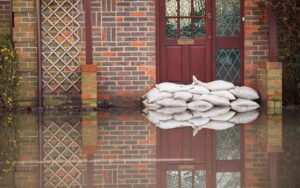

Author: Elizabeth Ruggles, NCARB, LEED AP (Senior ADA & Accessibility Consultant)
Accessibility compliance is an important aspect of any construction or building project and firms need to remember that there are numerous rules both at the federal and state level which can impact them.
When most people think about handicap accessibility in the United States, they typically associate it with the familiar blue signs and wheelchair friendly ramps that have become commonplace across the nation. However, accessibility is so much more than this and can be beautiful and a natural component of a project if it is done correctly and built in as early as possible. It requires proper planning, diligence and needs to be an ongoing effort for companies to avoid serious legal and monetary issues. Luckily, most construction companies want to actively be compliant and work to do so, but due to the numerous different regulations and different states having different rules, it can make navigating accessibility a headache for those newer to it.
It’s never too late during a construction project to ask for experts to evaluate Americans with Disabilities Act (ADA) and accessibility compliance, but like most things its always best to start as early as possible. By building accessibility in during the design and development phase, companies can ensure that if things need to go back to the drawing board, they are able to address those issues before ground is broken. Similarly, for acquisitions or updates to existing buildings, its similarly best to work with experts to check compliance sooner rather than later. It will always be easier to pivot or change a design element before it’s been built in.
While bringing in outside experts is a great way to ensure a project is compliant, its similarly important to ensure that all of the various internal construction crews and specialists that may touch a project are aware of the different rules that impact them. For example, for larger scale projects there could be different architects, plumbers, electricians, engineers and other experts working on different pieces of a project at different times, so ensuring alignment among all of them is important.
Similarly, as a part of the due diligence process, construction companies should check the local state regulations that could potentially impact them before they start a new project. While the Federal level ADA rules will be the same anywhere in the U.S., many rules are slightly different depending on the state a company is operating in. As an example accessible electric vehicle charging stations are not required for every facility type or in every municipality/state. It is important to know when modern technology requiring accessibility is adopted. Denver as of this year has adopted accessibility requirements for electric vehicle charging stations, but other states implemented this standard more than five years ago; and still other municipalities/states have not adopted requirements at this time. If you are a contractor or construction company that recently began working in the state, it can be very easy to overlook something like that.
When companies have experts look for accessibility issues that could potentially be flagged, it’s important to remember that the types of issues could be major components of the design, such as the ceiling or counter height. However, more frequently they are very minor components or design elements that most companies probably wouldn’t think about and could easily overlook. For example, even something as simple as a walk off mat in front of a property has the potential to raise accessibility issues. If a walk off mat in front of a property’s entranceway is not installed or positioned properly, it can potentially cause a tripping hazard. However, if the property is in a snowy or wet environment then a lack of mat can cause a slipping hazard. It’s a small nuance which could go either way depending on the situation, and its items like these where firms can easily run into issues if they are not careful.
Accessibility compliance is an important aspect of any construction or building project and firms need to remember that there are numerous rules both at the federal and state level which can impact them. However, with proper due diligence and being proactive with accessibility firms can identify issues before they arise and confirm compliance, mitigate their risk and protect themselves from potential ADA issues.

(Director of Civil Forensics at SBSA LLC, a Charles Taylor Company)
It’s no secret that water damage is a major threat to any community through storms, flooding, water line breaks, etc. However, water can also cause significant damage to a construction project. In most cases, the geotechnical reports that are prepared before a project begins strongly caution that water on a site must be carefully controlled during construction and after completion of the project. Yet, despite widespread awareness and warnings of the need to prioritize the prevention and/or mitigation of surface water during the planning and building process, the reality is that many companies are still struggling to get their arms around this very slippery problem.
Fortunately, while every project necessitates its own tailored plan, there is a tried-and-true framework that all construction companies can use as a starting point to avoid nightmare scenarios.
When a construction site experiences water damage, there are a few key factors in play. If caught early on, a construction company can work with outside experts to verify that the proper site grading was performed and that it has grading certificates prepared by a licensed surveyor stating that the site was graded in conformance with the applicable codes and design criteria. The company should also double check that the civil engineering and grading drawings clearly demonstrate the need to ensure that the ground is sloped away from buildings’ foundations to avoid flood damage. This is especially critical during the construction process when there are generally open excavations next to the buildings that make the newly constructed building elements extremely susceptible to water damage.
If adequate preventative measures such as preventing water near the foundations and open trenches, and a proper construction water-management plan have not been implemented or discussed yet, the expert can provide recommendations to the construction company about how to address these shortcomings.
In the cases where a structure has been already completed, a forensic expert can evaluate whether the building cracked, settled or otherwise sustained damage as a result of water. Ultimately, it’s important to double check every plan and water-management contingency before breaking ground. Even when it comes to liquid matter, it is still better to measure twice and cut once.
However, sometimes construction companies can do everything by the book and double check their work, and water damage might still occur in a number of ways.
For example, many construction companies find themselves dealing with water issues after the initial clearing of a site of vegetation and topsoil for the new construction. With the changes to the ground surface and existing vegetation removed, contractors can inadvertently cause runoff issues. This most generally can occur because the drainage flow patterns on the site are altered and because the bare ground results in greater quantities of runoff during rainfall events.
Similarly, construction sites can run into surface water issues as a result of impacting the existing underground drainage and water distribution systems while excavating. Rupturing a large high pressure water line on a construction site can cause significant damage to ongoing construction.
There are also documented cases where construction companies may have done everything possible to prevent water issues on their site, but because of the changes in the site imperviousness, grading and ground cover, the surface runoff from the site ends up impacting other neighboring and/or downstream properties, causing damages even when builders believed they had protected themselves from liability. In one case, development of a residential property resulted in negatively impacting a private stream and pond downstream of the site with the killing of fish and loss of use of the waterways.
One of the most important factors for construction companies to consider when planning for the risk of water damage is to carefully work with all the different disciplines that may touch or work on a construction site and ensure they are all aligned with the strategies in place to prevent water-damage issues. Whether this task is assigned to the overall designer who put together the initial plans, the general contractors implementing said plans or the landscaping contractors that may be involved in the later stages of the development, it is important to ensure that every group working on the project remains steadfast in following the same plan and the project is sub-coordinated at every level.
Another practice that is becoming more popular among construction companies is peer review, where outside third-party experts are asked to come in and evaluate a project’s plans and essentially review the designers’ and the construction company’s math and risk plan to make sure there are no inadvertent errors.
Additionally, new technologies like drones are making it easier for firms to confirm the correctness of the initial site grading, evaluate site risks and monitor these aspects of the project in real time as the construction progresses.
Ultimately, it is impossible to fully eliminate the risks or damages to construction projects due to human errors associated with construction project planning and evaluation water damage risk, but by leveraging outside help, double checking the design and drawings through peer review and leveraging new technologies to actively monitor sites, construction companies can get ahead of water risk and protect themselves from physical, legal or financial consequences that these water issues can create.
Charles Taylor Construction Engineering Technical Services (CTETS) is a leading provider of multidisciplinary expertise in design, construction, and property services. With a strong foothold in construction, legal, and insurance, our team of 50+ professionals specialize in forensic engineering, construction management, and property planning and redesign. Together, we offer a comprehensive suite of professional services that cover the entire spectrum of a building’s life cycle, from its conceptualization to rehabilitation.
 A recent study from the National Institute for Occupational Safety and Health (NIOSH) and the University of Illinois Chicago found that modern coal miners, particularly those in Central Appalachia, are more likely than their predecessors to die from respiratory diseases, according to the U.S. Department of Labor. (Photo illustration: Viktoriia/Adobe Stock)
A recent study from the National Institute for Occupational Safety and Health (NIOSH) and the University of Illinois Chicago found that modern coal miners, particularly those in Central Appalachia, are more likely than their predecessors to die from respiratory diseases, according to the U.S. Department of Labor. (Photo illustration: Viktoriia/Adobe Stock)
Published by ALM Media | PropertyCasualty360
When most people think of diseases and ailments impacting our nation’s workforce, coal workers’ pneumoconiosis (CWP), commonly known as “black lung disease,” would likely not be the first to come to mind.
For America’s coal industry, however, the infamous condition continues to plague miners and remains a complicated issue for those in the space.
Black lung represents a long-standing, incessant issue that is more complicated than most people think, especially given that the disease has the potential to impact someone for a lifetime. Handling the claims of those afflicted with black lung disease is vital to the miners and employers supporting life-long conditions.
To understand the situation with federal black lung, we need to go back to 1972, when American lawmakers first implemented the Black Lung Benefits Act. The intent was to provide monthly payments and medical benefits to coal miners disabled from black lung disease working in or around the nation’s coal mines. Additionally, the law requires employers to provide monthly benefits to dependent survivors if the disease caused the miner’s death.
Eligibility for benefits has changed over the years, most recently in 2010, when a policy change provided widows automatic benefits if the miner had filed their claim after Jan. 1, 2005. Prior to that from January 1982 to December 2004, the widow had to file their own claim and prove that the miner’s death was caused or hastened by black lung. Obamacare reinstated the law in effect prior to 1982.
Unlike state injury claims, the law forces federal black lung claims to go through a specific litigation process with the U.S. Department of Labor. In these situations, each party is allowed the same provisions to submit supportive and rebuttal evidence. Select experts approved by the DOL’s Black Lung Program evaluate testing results and if the evidence supports the worker’s claim, they will receive benefits.
Oftentimes, miners file federal and state claims simultaneously. Under the federal occupational disability regulations, if a plaintiff is awarded federal and state black lung benefits, the miner cannot receive indemnity benefits exceeding the federal rate. As a consequence, it becomes incumbent on the third-party administrator (TPA) to be knowledgeable of state and federal claims systems.
The federal occupational disability regulations provide the offset provision. Knowing the exact benefits which have been afforded to a miner is critical in assuring that benefits are paid properly to avoid indemnity overpayments. In addition, it is vital to confirm the type of state disability claim that a miner was awarded.
For example, if a miner is awarded federal benefits but also has a state occupational disability award for complicated coal workers’ pneumoconiosis (CWP), that miner’s medical benefits would fall under the state award and not the federal. This provides the TPA, representing the employer, more controls over the medical treatment in how its delivered. It subsequently offers the ability to secure fee schedule and PPO discounts on that treatment which reduces costs.
However, if the miner in that example was provided a state black lung award based on simple CWP then under that state claim the miner would only be entitled to certain medications and treatments for the condition per state regulations.
These complex medical matters require knowledgeable black lung claims management staff and a team of medical professionals to review the treatment to assure it is appropriate, necessary, and related to the condition of CWP. It’s also imperative that black lung adjusters, nurses, and physicians are experts in Occupational Disease and take a holistic approach when reviewing medical treatment associated with CWP, recognizing that not every treatment in relation to pulmonary functions are necessarily a result of this disease.
Particularly when looking at aging work forces, there are many factors that impact a miner’s health. It is essential that all factors are taken into consideration when making determinations of coverage of certain medical conditions.
One might assume that due to advances in technology, reduction in demand for coal, and awareness of the disease, black lung would be fading away and becoming less of a threat to coal miners and workers today. Surprisingly, the opposite is true. In fact, a recent study from the National Institute for Occupational Safety and Health (NIOSH) and the University of Illinois Chicago found that modern coal miners, particularly those in Central Appalachia, are actually more likely than their predecessors to die from black lung, as well as other lung diseases like COPD and lung cancer.
For the P&C industry, this counter-intuitive trend is an ongoing challenge. Like most modern industries, the coal mining industry has implemented a number of updated safety precautions to attempt to prevent and fight the disease among miners. These companies face a plethora of regulations surrounding their safety procedures and undergo regular inspections to ensure compliance.
So why have these measures not translated to lower rates of the disease among our mining workforces today?
The answer to the above question is tricky because of how black lung claims work. For example, many coal miners in the US are referred to as “frequent fliers” of the DOL claim process. This refers to claimants that will file a claim to obtain the DOL’s pulmonary evaluation but will then immediately withdraw their claim. There isn’t any restriction on how often you can do this, so many miners realize they can file as often as they want. This can lead to an artificial increase in black lung claims, even though the figures could just be reflective of a smaller group making multiple claims for themselves. A number of miners today are actually developing symptoms of black lung and trying to go through the system the right way. However, with the rising influx of claims these miner’s ‘legitimate’ claims can get buried beneath the many ‘frequent flier’ claims, making it a more tedious process and challenge for the P&C industry and DOL docket to determine which claimants are legitimate compared to others that might just be testing the waters.
On top of this is the fact that although a number of new safety regulations requiring miners to use special face masks and protective equipment exist, certain miners have been known to skip requirements because it’s easier for them to do their job despite the fact that the regulations are there to protect them. Many miners are adhering to the new types of guidelines being implemented, but with any industry going through change, there will always be resistance to it.
On top of increasing claims, the industry is also seeing liabilities increase. That’s according to a recent report from Milliman, which found that employer liabilities for black lung occupational disease claims have ballooned — to an estimated $9 billion and perhaps more than $14 billion as of last year. This may not be sustainable long term. The report concludes by noting that if employers are unable to pay the increasing number of claims, US taxpayers may ultimately be stuck with the check. To complicate matters, federal black lung claims may not be compromised or settled – and are one of the longest tail claims, providing lifetime benefits for affected miners, and dependent benefits for decades thereafter.
For the P&C industry, it’s clear that black lung isn’t going away, and although there continues to be a market-wide push for greater regulations and protections for workers, claims and liabilities for black lung are on the rise, so employers need to start thinking about what their long-term strategy for the disease will be.


(Robbie Arnold, Managing Director at Charles Taylor)
The withdrawal of large insurance carriers like Allstate and State Farm from California’s insurance market will have a significant impact on claims, at least one claims services provider has told Insurance Business.
Remaining carriers must shoulder huge nat-cat risks in the state, which often sees enormous claims from wildfire damage. Robbie Arnold (pictured), managing director at Charles Taylor, a global claims services provider, said he expects insurance companies to respond by tightening their underwriting and raising premiums.
“When you have a lot of carriers pulling out [of the market], it puts a lot of pressure on the existing companies to try to offset that risk with underwriting,” said Arnold. “So, they’ll start putting these large deductibles or special coverage limitations.”
Claims adjusters must strike a balance between advocating for policyholders and respecting policy limitations set by insurers, avoiding “adversarial situations” during the claims process.
“As claims professionals, we have to adjust to these new guidelines and communicate with the insureds what these policies represent,” Arnold added. “The balance is to try not to create adversarial situations.
“We want to be on the side of the policyholders, we’re trying to interpret policy, we’re trying to calculate damages and quantify the extent of the losses and give that information back to the carrier so that insureds can recover as soon as possible, especially from a property standpoint.”
Last month, California’s insurance market was rocked by announcements from State Farm, Allstate, Farmers, and AIG, saying they would stop sales of new policies, citing headwinds brought on by catastrophic weather events, inflation, and economic conditions.
Others, like Nationwide, have announced actions to curb further losses and to manage their property and casualty portfolios.
California’s insurance troubles are only just beginning, according to Arnold. Carriers could withdraw at a more rapid pace in the next few years, leaving fewer and fewer options for homeowners.
“We see issues coming into the next year and the year after, because as time progresses, it will become harder and harder to find policies,” he told Insurance Business.
Many carriers have already implemented rate increases to cope with losses, but with construction costs going up, more companies will feel pressure, Arnold added.
“They are accounting actuarially for what an average claim is going to be, but by the time the losses occur, everything will cost significantly more,” he said. “I see in the next year to five years is when California is really going to get into big trouble.”
California state regulators must work with the insurance industry to find solutions amid an increasingly challenging market for homeowners.
“I think the state could work with the carriers a bit better to find out where these rates need to sit,” said Arnold. “The problem is they don’t know how to price things out appropriately, and if the state doesn’t want to approve rate increases, they handcuff carriers into making decisions on whether to stop writing policies or withdraw from the state.
“[The state] needs to look at a deeper level to figure out how this works. For every premium dollar that comes in, [carriers] can’t pay out $1.50 in losses. It’s not a sustainable business model.”
Meanwhile, large players exiting California’s insurance market would also create more opportunities for remaining carriers, and leave spaces that can be filled by nimble, tech-driven entrants.
“A lot of [the players] in online marketplace can come in and be a little nimbler. They might be able to put policies in place with a little overhead, and that will allow them to take on additional risk,” Arnold said. “There’s certainly an opportunity for some aggressive young new companies to come in and stake a claim [in the market].”
By Gia Snape
July 05, 2023

During the week of June 5, the Northeast United States found itself coated in orange smoke and smog stemming from the ongoing wildfires in eastern Canada. It was an unusual experience for those unfamiliar with wildfires and the smoke-related air pollution they cause, and the latest reports indicate that the wildfires may only continue to intensify. In fact, according to the EPA, climate change has slowly increased the length, frequency and burn areas of wildfire seasons. For the insurance industry, these wildfires and their smoke risk and impact represent a unique and often complex issue, as the adjusting process for smoke damage can be nuanced and involve testing.
To address air pollutants and related damage, many leading adjusting firms have a specialized group that is focused on evaluating both the health risks and potential damages of wildfire smoke. One of the things these expert groups have revealed is solid soot, char and ash that fill the air are the biggest concern for human inhalation. Solid particles of smoke that are smaller than 2.5 microns can penetrate deep into the lungs and cannot be seen with the human eye. Smoke particles also can have a varying impact on those who inhale them, and those with existing pulmonary conditions are at a heightened risk.
Some states, like California, have instituted laws to protect outdoor workers from the risk of wildfire smoke, but this isn’t the case everywhere. Therefore, it is crucial for claimants to understand how different state laws can impact outcomes. For claims related to people and their health, environmental professionals often sample the indoor air with specialized meters to determine if a workplace has levels of smoke particles and various other toxic contaminants deemed safe by authorities. The EPA also produced its own app, called AirNow, which shows known airborne pollution levels throughout the U.S. and is a fantastic mobile-based tool for people to leverage when making travel or outdoor activity decisions or for businesses conducting outdoor projects in an area potentially impacted by smoke pollution.
The potential damage caused by wildfire smoke extends beyond just people. The very same solid soot, char, ash and various chemicals in the air also can impact properties and their contents. This includes everything from causing unpleasant odors and some minor, cleanable dust deposition to extreme and more rare cases, where the fire is adjacent and potentially causes selective physical damage to an interior or exterior, where the smoke is also particularly thick or corrosive. In this most recent smoke surge in the Northeast from far distant fires, the EPA does not foresee long-lasting health impacts for most healthy people. People more vulnerable to smoke must take additional steps to limit exposure.
Claims professionals for the most part recommend cleaning and deodorization, if necessary, for impacted structures and contents since wildfire smoke typically does not permanently damage most materials. Claims professionals can provide helpful and value-added advice to the insured, but the level of any assessment, testing or supplemental cleaning would be based on policy coverage.
Smoke damage claim evaluations are for the most part commonsense visual assessment and odor detection. Soot sponges can provide a direct qualitative indicator of potential fire deposition. For questionable or contested damage claims, surface sampling may be required. Claims professionals can additionally evaluate the exterior, interior, HVAC system and contents of a building to determine whether the smoke has created an impact greater than non-impacted “background.” Here’s what that means: Determining the impact of wildfire smoke is complex because of environmental factors, such as long-term air pollution impacts or site fireplace depositions. These can muddy the analysis, and investigators strive to find surfaces with both pre- and post-wildfire loss deposition to sample, generally with a tape-lift for subsequent laboratory microscopy analysis. The presence of wildfire indicator particles, such as burnt plants, minerals and pollens, may demonstrate an assemblage of particles which likely came from an outdoor fire. It can be a laborious process, since, for example, many older buildings can have existing cross-contamination from years of indoor/outdoor dust not being cleaned, such as in an old attic.
Ultimately, wildfire prevention is an increasingly shared responsibility, and while awareness is rising, climate change continues to exacerbate the issue. It’s important for both people and businesses to take steps to protect themselves. For example, utilities have been hardening their infrastructure against electrical fires, and many homeowners and builders may be facing regulatory requirements to protect buildings in wilderness areas, such as creating buffers or defensible spaces. Similarly, many companies seeking to minimize the impact of wildfire smoke now market small plug-in air particle meters that are affordable for homeowners. Whatever the case, these small changes can go a long way to prevent wildfire damage before it even happens and ultimately help individuals and businesses alike avoid having to make a wildfire damage claim in the first place.
Author: Greg Sisson, Chief Claims Officer – TPA
The worst of the COVID-19 pandemic might be behind us, but are you prepared for the next public health crisis? The risk of uncertainty is an expensive one, and to not “expect the unexpected” results in a far heftier price. The current inflationary environment on the heels of COVID-19 is a prime example of such.
While we are all likely sick of talking about the pandemic, the reality is that it brought a fresh onslaught of risks and exposed a long list of challenges that could impact municipalities for decades to come. From infrastructure damage to emerging technology, workers’ compensation, discrimination and cyber risk, public municipalities have never been so vulnerable to risk.
In order to know where to start in future-proofing, we must first analyze the risks currently impacting municipalities and their constituents:
By 2030, the frequency of weather events such as heatwaves, droughts and extreme rainstorms will all more than double (1). These events have far reaching impacts on every community. Droughts can harm food production and human health. Flooding can lead to disease spread and damage to infrastructure. Many communities aren’t prepared to face climate-related threats, which will cost their communities even more if they don’t prepare now.
Any organization that stores sensitive or personal information such as addresses, social security numbers or payment details are at risk from cyber criminals who try to steal data from your computer systems. Most commonly using ransomware, cyber criminals on average demand more than $200,000 in exchange for that information (2). The cost of these breaches goes far beyond the original act itself and can have lasting consequences for your community in the amount of millions taxpayer dollars. Last year, the average cost of a data breach was just under $4 million dollars. (3)
While the above may be daunting, there are immediate steps municipalities can take to minimize liability and build business continuity planning into their strategy:
Every community faces unique environmental challenges. In the event of an extreme weather event a successful response will be based on preparedness. Careful planning can save lives and prevent damage to vital infrastructure. Technology can help reduce complexity, increase communication, and assist those responsible for community safety.
There steps to help prevent a cyber-attack including securing your systems and data using multi-factor authentication (MFA). MFA is a security method that can help stop cyber-attacks. Maintaining your computer equipment, conducting a risk assessment of each system, and evaluating your technology solutions providers are additional ways to help mitigate the risk (4).
Ultimately, those who fail to learn the lessons of the pandemic and choose not to put the right protocols in place greatly increase the cost and risk exposure for public municipalities. But with these steps to future-proof and risk management, public municipalities can better stay ahead of the next health crisis, recession, and more.
The Accelerating Frequency of Extreme Weather Events (visualcapitalist.com) (1)
Ransomware demands up by 43% so far in 2021, Coveware says – CyberScoop (2)
Cost of a data breach 2022 | IBM (3)
How Cities, Counties and Municipalities Can Reduce Cost of Risk | Travelers Insurance

Christopher Schaffer, our CEO Claims Solutions, The Americas, was recently featured in a Business Insurance Comp Spotlight interview. Chris provided great insight on how inflation has impacted Third-Party Administrators like Charles Taylor and how to prevent some of its adverse effects.
Click here for the full interview: Video: Comp Spotlight with Chris Schaffer of Charles Taylor | Business Insurance